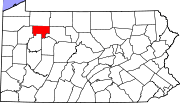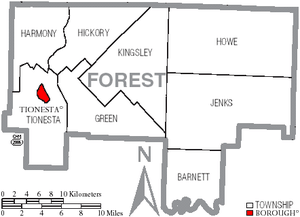Forest County, Pennsylvania
| Forest County, Pennsylvania | |
|---|---|
 Location in the U.S. state of Pennsylvania | |
 Pennsylvania's location in the U.S. | |
| Founded | September 1, 1857 |
| Seat | Tionesta |
| Largest community | Marienville |
| Area | |
| • Total | 430 sq mi (1,114 km2) |
| • Land | 427 sq mi (1,106 km2) |
| • Water | 3.3 sq mi (9 km2), 0.8% |
| Population (est.) | |
| • (2015) | 7,410 |
| • Density | 17/sq mi (7/km²) |
| Congressional district | 5th |
| Time zone | Eastern: UTC-5/-4 |
| Website |
www |
Forest County is a county located in Western Pennsylvania. As of the 2010 census, the population was 7,716,[1] making it the third-least populous county in Pennsylvania. Its county seat is Tionesta.[2] The county was created in 1848 and later organized in 1857.[3]
History
Forest County was created on April 11, 1848, from part of Jefferson County. The county was enlarged on October 31, 1866, when part of Venango County was incorporated into the county. Forest County was named for the forests contained within its limits.[4]
Geography
According to the U.S. Census Bureau, the county has a total area of 430 square miles (1,100 km2), of which 427 square miles (1,110 km2) is land and 3.3 square miles (8.5 km2) (0.8%) is water.[5]
Adjacent counties
- Warren County (north)
- McKean County (northeast)
- Elk County (east)
- Jefferson County (south)
- Clarion County (south)
- Venango County (west)
National protected area
Part of Allegheny National Forest covers Forest County.
State protected area
Part of Cook Forest State Park is in Forest County.
Demographics
| Historical population | |||
|---|---|---|---|
| Census | Pop. | %± | |
| 1860 | 898 | — | |
| 1870 | 4,010 | 346.5% | |
| 1880 | 4,385 | 9.4% | |
| 1890 | 8,482 | 93.4% | |
| 1900 | 11,039 | 30.1% | |
| 1910 | 9,435 | −14.5% | |
| 1920 | 7,477 | −20.8% | |
| 1930 | 5,180 | −30.7% | |
| 1940 | 5,791 | 11.8% | |
| 1950 | 4,944 | −14.6% | |
| 1960 | 4,485 | −9.3% | |
| 1970 | 4,926 | 9.8% | |
| 1980 | 5,072 | 3.0% | |
| 1990 | 4,802 | −5.3% | |
| 2000 | 4,946 | 3.0% | |
| 2010 | 7,716 | 56.0% | |
| Est. 2015 | 7,410 | [6] | −4.0% |
| U.S. Decennial Census[7] 1790-1960[8] 1900-1990[9] 1990-2000[10] 2010-2013[1] | |||
As of the census[11] of 2000, there were 4,946 people, 2,000 households, and 1,328 families residing in the county. The population density was 12 people per square mile (4/km²). There were 8,701 housing units at an average density of 20 per square mile (8/km²). The racial makeup of the county was 95.94% White, 2.22% Black or African American, 0.40% Native American, 0.14% Asian, 0.69% from other races, and 0.61% from two or more races. 1.21% of the population were Hispanic or Latino of any race. 38.1% were of German, 13.9% Irish, 8.1% American and 7.8% English ancestry according to Census 2000.
There were 2,000 households out of which 23.20% had children under the age of 18 living with them, 55.70% were married couples living together, 6.70% had a female householder with no husband present, and 33.60% were non-families. 29.10% of all households were made up of individuals and 15.10% had someone living alone who was 65 years of age or older. The average household size was 2.29 and the average family size was 2.81.
In the county, the population was spread out with 22.70% under the age of 18, 5.90% from 18 to 24, 22.60% from 25 to 44, 28.90% from 45 to 64, and 19.90% who were 65 years of age or older. The median age was 44 years. For every 100 females there were 111.20 males. For every 100 females age 18 and over, there were 102.30 males.
- Birth rate
Forest County's live birth rate was 52 births in 1990. The County's live birth rate in 2000 declined to 40 births, while in 2011 it had declined again to 39 babies.[12] Over the past 50 years (1960 to 2010), rural Pennsylvania saw a steady decline in both the number and proportion of residents under 18 years old. In 1960, 1.06 million rural residents, or 35 percent of the rural population, were children.
- County poverty demographics
According to research by The Center for Rural Pennsylvania, which is a legislative Agency of the Pennsylvania General Assembly, the poverty rate for Forest County was 21.9% in 2014.[13] The statewide poverty rate was 13.6% in 2014. The 2012 childhood poverty rate at Forest Area School District was 57.8% living at 185% or below than the Federal Poverty Level.[14]
- Teen Pregnancy rate
Forest County reported no babies born to teens (age15-19) in 2011. In 2015, the number of teen births in Forest County was 16.[15]
Education
The Forest Area School District serves the entire Forest County. The District ranked 421st out of the 493 ranked Pennsylvania school districts in 2015.[16]
Private schools
- Cornell Abraxas I Arlene Lissner (9th-12th) Marienville
Libraries
- Marienville Area Library
- Sarah Stewart Bovard Memorial Library - Tionesta
- Forest County Library Board - Tionesta
- Forest County Literacy Council
Communities

Under Pennsylvania law, there are four types of incorporated municipalities: cities, boroughs, townships, and, in at most two cases, towns. The following boroughs and townships are located in Forest County:
Boroughs
- Tionesta (county seat)
Townships
Census-designated place
Population ranking
The population ranking of the following table is based on the 2010 census of Forest County.[17] The jump in census figures between the 2000 and 2010 census, is due in a large part to the opening of the State Correctional Institution- Forest (SCI- Forest) in October 2004. SCI Forest houses approximately 2,200 inmates at their facility in Marienville, PA.
† county seat
| Rank | City/Town/etc. | Population (2010 Census) | Municipal type | Incorporated |
|---|---|---|---|---|
| 1 | Marienville | 3,137 | CDP | |
| 2 | † Tionesta | 483 | Borough | 1805 |
See also
References
- 1 2 "State & County QuickFacts". United States Census Bureau. Retrieved November 17, 2013.
- ↑ "Find a County". National Association of Counties. Retrieved 2011-06-07.
- ↑ "Pennsylvania: Individual County Chronologies". Pennsylvania Atlas of Historical County Boundaries. The Newberry Library. 2008. Retrieved March 12, 2015.
- ↑ Gannett, Henry (1905). The Origin of Certain Place Names in the United States. Govt. Print. Off. p. 128.
- ↑ "2010 Census Gazetteer Files". United States Census Bureau. August 22, 2012. Retrieved March 7, 2015.
- ↑ "County Totals Dataset: Population, Population Change and Estimated Components of Population Change: April 1, 2010 to July 1, 2015". Retrieved July 2, 2016.
- ↑ "U.S. Decennial Census". United States Census Bureau. Retrieved March 7, 2015.
- ↑ "Historical Census Browser". University of Virginia Library. Retrieved March 7, 2015.
- ↑ Forstall, Richard L., ed. (March 24, 1995). "Population of Counties by Decennial Census: 1900 to 1990". United States Census Bureau. Retrieved March 7, 2015.
- ↑ "Census 2000 PHC-T-4. Ranking Tables for Counties: 1990 and 2000" (PDF). United States Census Bureau. April 2, 2001. Retrieved March 7, 2015.
- ↑ "American FactFinder". United States Census Bureau. Retrieved 2008-01-31.
- ↑ Pennsylvania Department of Health, Birth Age County Reports 1990 and 2011, 2011
- ↑ US Census Bureau (2015). "Poverty Rates by County Small Area Income and Poverty Estimates".
- ↑ Pennsylvania Budget and Policy Center (2012). "Student Poverty Concentration 2012".
- ↑ Robert Wood Johnson Foundation, (2016). "Pennsylvania Teen Births 2015,".
- ↑ Pittsburgh Business Times (April 10, 2015). "Guide to Pennsylvania Schools Statewide School District Ranking 2015".
- ↑ http://www.census.gov/2010census/
Coordinates: 41°31′N 79°14′W / 41.52°N 79.24°W